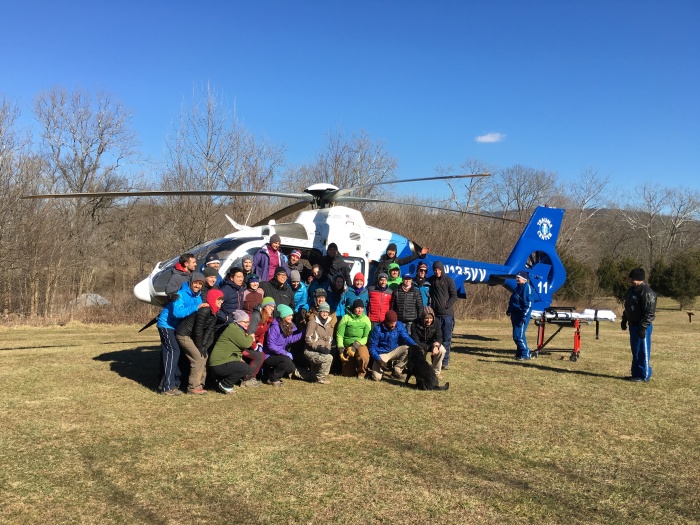
Lifeguard 11 at the 2016 WMS Elective last week, took report on and loaded a mock patient. They hung out for students to tour the helicopter
As one of the co-directors of the 2016 WMS Elective in Wilderness and Environmental Medicine, along with Dr. Erin Meyer and Dr. Stephanie Lareau, I was privileged to spend last week in rural Virginia teaching and living Wilderness Medicine with 30 medical students and residents from the US, Australia, UK, South Africa and Canada. The students are spending a month at Wilderness Adventure learning the nuts and bolts of wilderness medicine, with a sprinkle of leadership and team-building from experts across the country, including world-class mentor and role model, Dr. Luanne Freer, founder and director of the Everest ER.
Last week the students gained a host of Wilderness First Responder (WFR) skills that led to their ability to rescue several mock patients who were “plane crash victims.” During this scenario, the students’ tasks included a Search and Rescue (SAR) operation, field treatment of life-threatening injuries, and designing and executing evacuation of their patients in the Blue Ridge Mountains of Virginia in single digit temps, up and down steep-pitched hills at night. And that was only week two of four. Their course culminates at the end of the month with a backpack week where they design their own routes and meals, and will be faced with several more wilderness scenarios to sort out before making it back to the comfort of Wilderness Adventure. Check out their updates on the Student Blog.

Skills Session before scenarios

Cold Water Immersion Scenario
At this point in my Wilderness Medicine life, new colleagues are now old friends, spine guidelines in field treatment have come and gone and evolved, and coming full circle round with great pride, one of my former students, Dr. Lara Phillips, is now the faculty director of the Mid-Atlantic Student Wilderness Medicine Conference (MASWM) taking place in Philadelphia April 9-10. This month down in the Blue Ridge Mountains of Virginia, that baton gets passed along to 30 lucky students taking the WMS Elective in Wilderness and Environmental Medicine.
Upcoming Learning Opportunities in Wilderness Medicine
For anyone interested in getting your minds opened and your hands dirty, consider upping your Wilderness Medicine IQ in some of these awesome settings. Happy (and safe) trails!
Wilderness and Mountain Medicine February 20-24 (next week) in Park City, UT
MASWM April 9-10, 2016 in Philadelphia, PA
Southeast Student Wilderness Medicine Conference April 23-24 in Roanoke, VA
Southern Utah Canyonlands Adventure CME May 15-22, Grand Staircase Escalante ,UT
WM and AWLS for First Year Medical Students, June 5-11, Canoeing in Southwest Alabama, taught by UC Denver Medical School Faculty
World Congress on Wilderness and Mountain Medicine July 30-August 1, Telluride, CO




